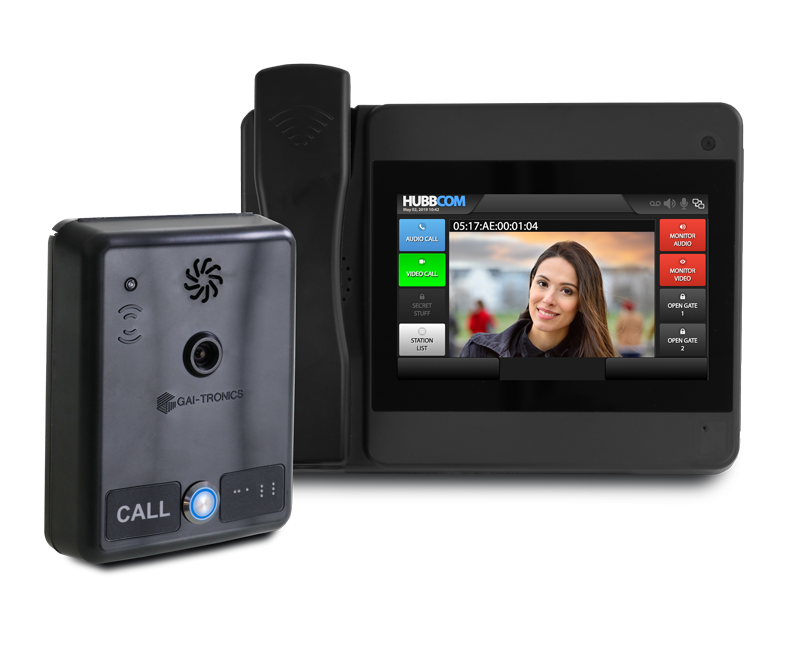



Return to Work:
Smart Solutions for Health & Safety
Businesses across the globe are hard at work combatting the spread of COVID-19 and are taking a serious look at new technologies and ways to enhance health and safety at work. With the pandemic top of mind, manufacturers are developing solutions that businesses can immediately implement to adapt to today’s new normal. This adaptation starts at the front door with a satisfactory body temperature reading. Entryways – especially when unmanned, pose challenges to safety that present excellent opportunities for smart controls. One of the biggest challenges is touch – by necessity, entryways are busy places frequently used by employees and visitors alike. Reducing the need for people to physically touch surfaces in turn the risk of contamination. However, with touchless entry, infected people could still enter the facility. An opportunity to protect against potential contamination exists in temperature monitoring. By utilizing simple, noninvasive temperature screening, people exhibiting an elevated body temperature can be denied entry, preventing the spread of illness. Let’s examine ways to reduce touch and introduce temperature screening.
Reducing the Workload of Manual Temperature Scanning

Today, most businesses use handheld temperature scanners to monitor the body temperatures of people seeking entry to a building. Manufacturers are developing solutions to automate this process to reduce the need for face-to-face contact and manual workload. Non-contact infrared thermometers (NCIT) are a good choice, but care must be taken to ensure accuracy. The NCIT is affected by factors such as distance from the subject, ambient room temperature, sunlight and the presence of drafts or other air currents. When implementing NCITs, a best practice is to ensure installation in draft-free locations away from radiant heat sources and out of direct sunlight. The ambient room temperature should range from 60 and 104°F (15 to 40°C). For best results, allow the device to acclimatize to the ambient temperature for at least 30 minutes before use.
Since the need for temperature scanning technology is increasing, it’s important to stay on top of the solutions and devices available in today’s marketplace. The most common device for this application is handheld temperature scanners. This form of temperature scanning requires an employee to be stationed in an entry way while physically scanning the temperatures on those entering a building. Handheld temperature scanners are inexpensive and do not require installation. While convenient and cost effective, handheld scanners pose two primary challenges: labor intensity and the need for face-to-face contact.
Optimizing Access Control Systems

As businesses work to combat germs and adapt to today’s normal, access control is now a long-term top-of-mind consideration. Companies are taking a hard look at their current systems and determining ways to optimize their effectiveness in enhancing everyone’s health and safety. Access control systems require installation inside a facility. Systems range from simple tripod mounts to permanent fixtures and are available as standalone or networked devices. Standalone access control devices are simple as they do not require integration with a facility’s network and are by nature, easy to install. Standalone devices are also equipped with a variety of reporting methods. Traditional systems are known to allow connection to an external HDMI monitor, while more modern devices have a built-in screen. While both system types are effective, devices with built-in screens offer straightforward deployment and external monitor-type devices allow for more flexibility with setup.
To emphasize the importance of monitoring, standalone devices allow building’s management to choose between self-monitoring and third-party monitoring. Self-monitoring eliminatesthe need for an attendant and is ideal where employees can be trusted to take the appropriate course of action if they fail the test. In this case, the monitor must face the person being scanned and provide a clear “go/no-go” indication. Of course, self-monitoring is not advisable for visitor entrances. It is recommended that entrances where visitors enter or seek entry be monitored by a third-party.
"As businesses work to combat germs and adapt to today’s normal, access control is now a long-term top-of-mind consideration."
While appropriate for some applications, standalone systems are not always the best solution. Instances include situations where it is undesirable to publicly identify subjects with high temperatures (some schools prohibit this) or where a central security office monitors multiple entrances. For such applications, a networked solution is appropriate. Networked solutions consist of a simple scanner at the entryway. Temperature reporting is done via the remote monitor or by text (or other notification) on a mobile device. Networked temperature scanning systems also have the capability of being be integrated with an access control system. Certain devices require visitors with access cards to submit to a temperature scan after the card has been accepted. In this two-step process, only visitors with valid credentials and a temperature within the pre-determined threshold is granted access to the building.
While appropriate for some applications, standalone systems are not always the best solution. Instances include situations where it is undesirable to publicly identify subjects with high temperatures (some schools prohibit this) or where a central security office monitors multiple entrances. For such applications, a networked solution is appropriate. Networked solutions consist of a simple scanner at the entryway. Temperature reporting is done via the remote monitor or by text (or other notification) on a mobile device. Networked temperature scanning systems also have the capability of being be integrated with an access control system. Certain devices require visitors with access cards to submit to a temperature scan after the card has been accepted. In this two-step process, only visitors with valid credentials and a temperature within the pre-determined threshold is granted access to the building.
Keeping Health and Safety Top-of-Mind
Ultimately, there is a wide range of solutions that can be implemented to enhance everyone’s health and safety while working to combat the spread of germs and illnesses. It is imperative now more than ever that facility managers get the most out of their access control system. No matter which method is chosen to protect a facility, whether it’s reducing touch points, optimizing the way temperatures are taken or both, one thing is clear – once the threat of COVID-19 passes, the need for increased protection from disease will remain with us for the foreseeable future.